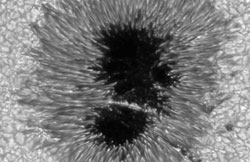Meteorites record past solar activity

A sunspot the size of the Earth. Sunspots result from the solar magnetic activity. Credit: Max Planck Institute for Solar System Research, Dr. Vasily Zakharov. Image taken with the Swedish Solar Telescope on the island of La Palma.
They compare the amount of Titanium 44 in nineteen meteorites that have fallen to the Earth over the past 240 years. Their work confirms that the solar activity has increased strongly during the 20th century. They also find that the Sun has been particularly active in the past few decades.
I. Usoksin and his colleagues have used meteorites to reconstruct past solar activity. Studying the earlier activity of our Sun is one of the oldest astrophysical projects, as astronomers began recording the number of sunspots to trace the Sun's magnetic activity four hundred years ago.
The international team examined a set of nineteen meteorites whose dates of fall are precisely known, and measured the amount of radioactive isotope Titanium 44 in these meteorites. Titanium 44 is produced by the cosmic rays in the meteorites while they are outside the Earth’s atmosphere. After the meteorite has fallen, it stops producing this isotope. By measuring the Titanium 44 in these meteorites, they are able to determine the level of solar activity at the time the meteorite fell.
Past solar activity is reconstructed with this technique in an independent way, that is, one not affected by terrestrial effects. How high the solar activity was at a given epoch was previously known from measuring the concentration of cosmogenic isotopes produced at that time. But most of the isotopes found on the Earth – in Greenland and Antarctic ice sheets or in tree rings, for instance – are also affected by terrestrial processes, in these examples related to the Earth’s magnetic field and climate. Until now, reconstructing past solar activity was thus very uncertain. This is shown by how various reconstructions that were previously published differ from one other. In the new study to be published this week in Astronomy & Astrophysics Letters, the team shows that the Sun is currently particularly active compared to earlier centuries.
[1] The team includes N. Bhandary (Basic Sciences Research Institute, Ahmedabad, India), G.A. Kovaltsov (Ioffe Physical-technical Institute, St. Petersburg, Russia), S.K. Solanki (Max-Planck Institute for Solar System Research, Katlenburg-Lindau, Germany), C. Taricco (Istituto Nazionale di Fisica Nucleare, Torino, Italy) and I.G. Usoskin (University of Oulu, Finland).
Media Contact
All latest news from the category: Physics and Astronomy
This area deals with the fundamental laws and building blocks of nature and how they interact, the properties and the behavior of matter, and research into space and time and their structures.
innovations-report provides in-depth reports and articles on subjects such as astrophysics, laser technologies, nuclear, quantum, particle and solid-state physics, nanotechnologies, planetary research and findings (Mars, Venus) and developments related to the Hubble Telescope.
Newest articles

Superradiant atoms could push the boundaries of how precisely time can be measured
Superradiant atoms can help us measure time more precisely than ever. In a new study, researchers from the University of Copenhagen present a new method for measuring the time interval,…

Ion thermoelectric conversion devices for near room temperature
The electrode sheet of the thermoelectric device consists of ionic hydrogel, which is sandwiched between the electrodes to form, and the Prussian blue on the electrode undergoes a redox reaction…

Zap Energy achieves 37-million-degree temperatures in a compact device
New publication reports record electron temperatures for a small-scale, sheared-flow-stabilized Z-pinch fusion device. In the nine decades since humans first produced fusion reactions, only a few fusion technologies have demonstrated…





















